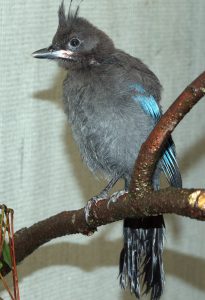Support Us
Since 1979 more than 140,000 animals have been treated by Wildlife Rescue.
Thanks to the support of individuals like you, Wildlife Rescue can provide a lifeline for animals in distress.
Voted as BC’s official bird in 1987, Steller’s Jays are known for their beautiful blue colour on their wings and the unique black plume of feathers on their heads. These birds are a staple of the West and frequent visitors in campgrounds, parks, and picnic grounds.
Steller’s Jays live in dense forests, mountains, and suburbs with small woods. Their primary food sources are nuts and acorns – which they open by hitting their bills – and find high in trees and occasionally on the ground. Steller’s Jays will also eat berries, wild fruit, insects such as beetles and bees. Steller’s Jays are opportunists and will steal from other birds or keep an eye for handouts from people.

Fortunately, these magnificent birds are generally adaptive, and their population has continued to grow since the 70s. But threats such as urbanization, human disturbances, predator attacks, and natural challenges lead to trouble. The Steller’s Jay has learned to hang around campsites and picnic grounds to scavenge for crumbs on the ground. Sadly, foraging on the ground leaves them more vulnerable to cat attacks – attacks that account for nearly a billion bird deaths each year.
Recently, three Steller’s Jay fledglings have been admitted to Wildlife Rescue due to predator attacks and nest disturbances. These fledglings are in the important stage to learn to fly, self-feed, and navigate the wild, however; these challenges prevent their journey to continue in the wild. Nevertheless, these cases are preventable with some simple adjustments.
Many birds are harmed each year due to predator attacks – birds such as Steller’s Jays are often hurt after being ambushed by a cat when foraging on ground-level. Fledgling Steller’s Jays are even more vulnerable, they spent time on the ground learning how to fly. You can help prevent predator attacks in your yard!
We can also support Steller’s Jays in our own backyards!
We can also support these birds by planting bushes. Creating shelter for these birds is another way to help these unique birds – planting bushes that provide shelter will assist them in their fight for survival.
Of course, protecting injured birds is a great way to help. If you see a bird that has exposed bone or blood, bugs or insects covering it, no feathers, or a bird that is sleeping, human intervention is required. Please contact our Support Centre for assistance.
Preventing cat attacks and keeping Steller’s Jays safe is a simple way to protect your environment and help these species thrive.
Help vulnerable species thrive today!